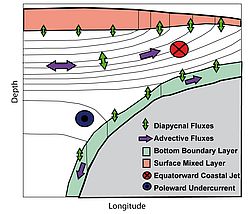The major goal of this new subproject is to estimate transport and fluxes of solutes between the bottom boundary layer, the stratified interior ocean and the ocean mixed layer on the continental slope and shelf regions of the Peruvian and Mauritanian Oxygen Minimum Zones (OMZ). Subproject A8 will contribute to the understanding of the solute budget of the OMZs and establishes a link between the benthic and pelagic research foci within the SFB.
The oxygen minimum and nutrient maximum found in a large part of the tropical southeastern Pacific and the northeastern Atlantic Oceans are the result of sluggish circulation, long residence timescales, and remineralisation of the organic matter coming from the highly productive surface layer present over large parts of the region. Nutrients such as ammonium, phosphorus, iron and silicate that are released from the seabed contribute to the nutrient budget of the OMZs and to high primary productivity in the euphotic zone above. On the other hand, the seabed represents a sink for dissolved oxygen, nitrate and nitrite and thus contributes to the consumption of oxygen and to the removal of reactive nitrogen within the OMZs.
The overall goal of A8 is to improve the understanding of the contribution of solutes released from or up taken by the sediments to the solute budgets of the OMZs and to the production within the ocean mixed layer at the continental margins off Peru and Mauritania. The objectives are:
- to investigate pathways of solutes from the sediments into the stratified ocean and the upwelling region above;
- to quantify diapycnal fluxes of solutes across the bottom boundary layer, in the stratified interior and into the mixed layer;
- to quantify advective/lateral diffusive fluxes of solutes in the bottom boundary layer and the interior stratified ocean;
- to advance the understanding and parameterization of the physical processes controlling the solute fluxes between the sediments and the interior OMZ.



